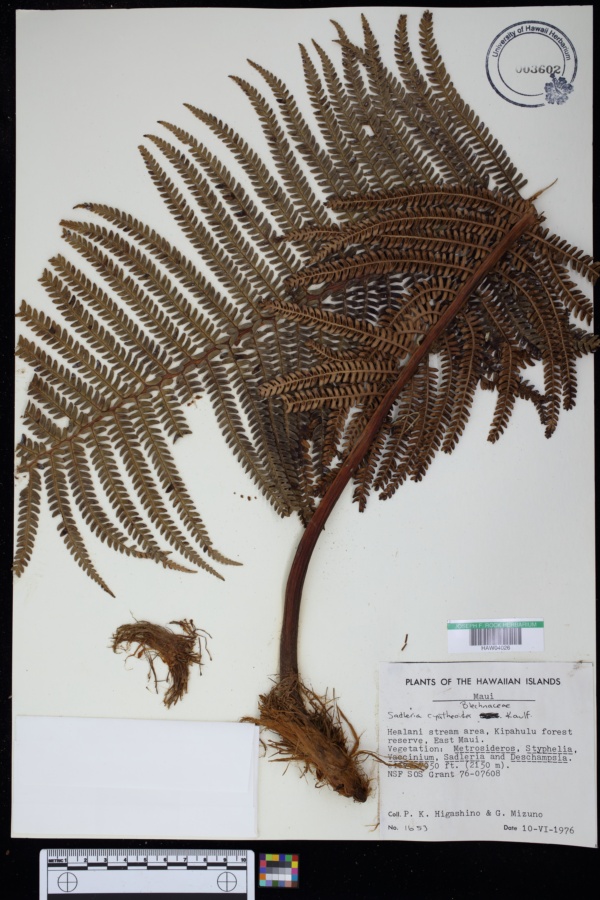
|
Family: Blechnaceae |
The Hawaiian names for the Sadleria in the Cyatheoides group are 'ama 'u, rna 'u, rna 'uma 'u, pua'a 'ehu'ehu (red pig), and 'ama'uma'u (P. & E. interpret 'ama'uma'u as meaning young 'ama 'u ferns; many 'ama 'u ferns, ferny, abounding in 'ama 'u ferns; a covering of 'ama 'u ferns). Name honors Dr. Joseph Sadler (1791-1849), a physician who studied the ferns of his native Hungary. Plants small to large, terrestrial. Rhizomes erect to decumbent, varying from short and slender to large and trunklike, scaly. Fronds erect to drooping, sometimes pendent. Stipes grooved, varying from long, thick, and straw-colored to short, thin, and dark brown to purple, with linear, tan to dark aerophores along entire length on both sides; scales entirely covering stipes or limited to bases, ranging from short, narrow, triangular, and !-colored to lineartriangula and 2-colored with dark midrib and tan margins, or large, thin, tan, and matted. Blades 1-pinnate-pinnatifid to 2-pinnate, margins glandular or not; rachises covered with scales or glabrous. Pinnae sessile or short-stalked, short and obtuse to linear-triangular and acute, glandular or not. Ultimate segments numt:rous, adnate, connected by a vertical line of cartilage extending from costa to base of sinus or not, ovate, or obtuse to linear-falcate. Veins forked, free except where they unite to form pericostal arches. Sori long, linear, borne on commissures near costae of ultimate segments. Indusia opening inward. An endemic Hawaiian genus of six species easily divided into two groups: the Cyatheoides group of medium-sized to large, even tree, ferns found in diversehabitats from recent lava flows to mesic and wet forests (S. cyatheoides, S. pallida, S. souleyetiana, and S. wagneriana), and the Squarrosa group of small ferns of dark, wet banks (S. squarrosa and S. unisora). In Hawaiian theology, 'ama 'u is one ofthe forms that the pig demigod Kamapua 'a assumes at will. A red dye for kapa (bark cloth) was extracted from the cortex of the trunk of the larger Sadleria species, and the starchy pith was occasionally cooked and eaten. Rolled-up fronds of the 'ama 'u fern (palaholo) or a paste made from the pulpy sap of the fronds, which acts as a mucilaginous glue, was used to weld kapa strips together or to repair kapa. In thatching houses, Hawaiians might tie a row of Sadleria fronds lengthwise along the ridgepole and to the comer ridges to help make these parts waterproof. If pili grass (Heteropogon contortus) was scarce, 'ama 'u fronds might be used to thatch the whole roof and even to cover the walls. The fronds were also used for temporary shelters in the forest. Sadleria fronds were used as a mulch for vegetable gardens in drier parts of the Islands. Pukui included mention of 'ama 'u ferns: Huli ka !au o ka 'ama 'u i uka, nui ka wai o kahawai. (When the leaves of the 'ama'u tum toward the upland, it is a sign of a flood.) When the wind blows the leaves of the 'ama 'u fern so that they bend toward the mountains, it is also blowing clouds inland, which will produce rain (Pukui 1983). Pepe'e a palaholo (a rolled-up frond of 'ama'u) describes the 'ama'u ferns that furnish sap used in kapa making. Implies the same thought as the saying, "Great oaks from little acorns grow." 1. Fronds erect, medium-sized to large, 30-350 em or more long; blades 1-pinnate-pinnatifid to 1-pinnate-pinnatisect or 2-pinnate at base of larger pinnae; ultimate segments linear-oblong to linear-falcate, usually longer than 8 mm; scales without glandular hairs (except S. wagneriana); plants not limited to steep, dark, moist banks (except 23 S. wagneriana) ................................. . Cyatheoides group (2). 1. Fronds drooping, small, usually less than 30 em long; blades 2-pinnate; ultimate segments round to ovate or ovate-lanceolate, shorter than 6 mm; scales with glandular hairs; plants restricted to steep, dark, moist banks .......................................... Squarrosa group (5). 2(1). Veins evident (venation viewed from abaxial surface, with magnification, by transilluminating mature segments with a bright background; young fronds are often difficult to interpret, so older fronds should be examined); basiscopic basal pinna segments often enlarged, pinnatifid, and overlying rachises, or not (3). 2. Veins obscure, except on distal 1/8 where they end in hydathodes; basiscopic basal pinna segments seldom enlarged and overlying rachises (4). 3(2). Stipe base scales thin, broad, tan, resembling matted tissue paper; basiscopic basal pinna segments often enlarged, pinnatifid, and overlapping rachises; veins ending in hydathodes, not touching margins of segments; all major islands ............................................ 3. S. souleyetiana 3. Stipe base scales linear-triangular, predominantly stiff, bicolorous with dark center, and light brown margins; basiscopic basal pinna segments usually not enlarged, pinnatifid, or overlying rachises; veins extending to, and touching, cartilaginous margins of segments; all major islands . . . . . . . . . . . . . . . . . . . . . . . . . . . . . . . . . . . . . . . . . . . . . . . . 2. S. pall ida 4(2). Scales soft, linear-triangular, light to dark brown, tapering to long, curly, often tom, hairlike tips; ultimate segments linear-oblong to falcate, tips often pointed; glands absent on abaxial surface of ultimate segments; usually in open, sunny mesic to wet forests; all major islands .. I. S. cyatheoides 4. Scales linear-ovate, broad, tan, resembling matted wet tissue paper; ultimate segments rectangular, tips obtuse; glands translucent, tan, plentiful on abaxial surfaces of ultimate segments; plants on damp, steep, dark stream walls; Kaua'i ....................................... 6. S. wagneriana 5(1). Scales linear-triangular, light brown to brown, abundant along entire stipes and rachises; stipes 4-5+ mm diam. at base; pinnae 1.8-11 cm long, tips acute; ultimate segments 12-25+ per pinna, ovate to ovate-lanceolate; all major islands ....................................... 4. S. squarrosa 5. Scales linear-attenuate, dark reddish brown, sparse on stipes and rachises; stipes 1-3 mm diam. at base; pinnae 1.9-3.5 em long, tips obtuse; ultimate segments 3-7 pairs per pinna, round to ovate; Kaua 'i ..... 5. S. unisora |


